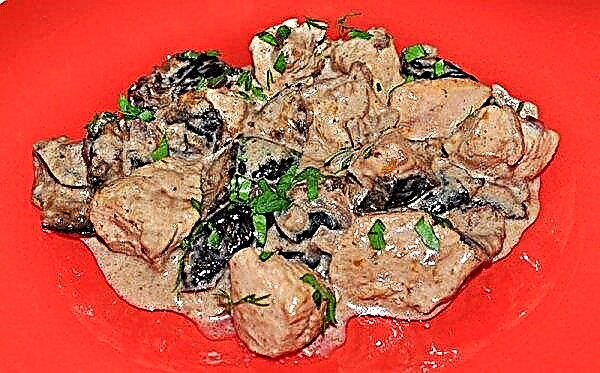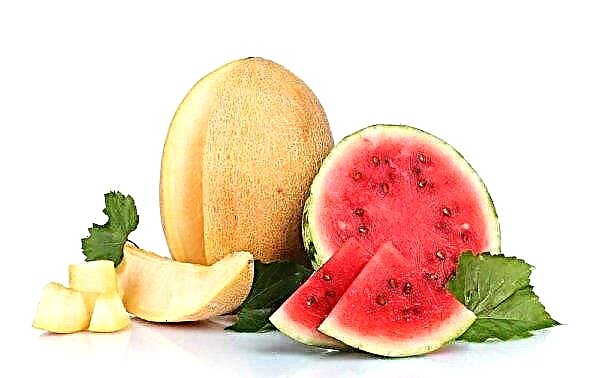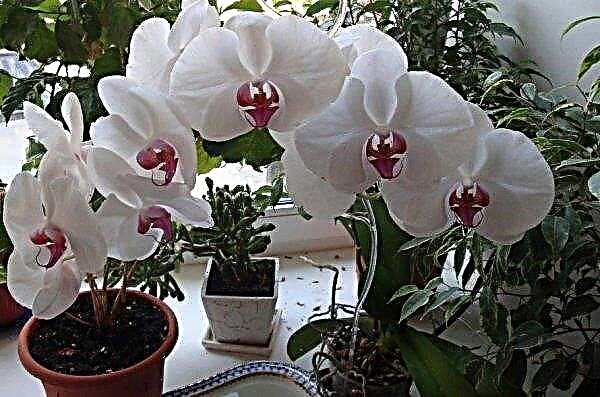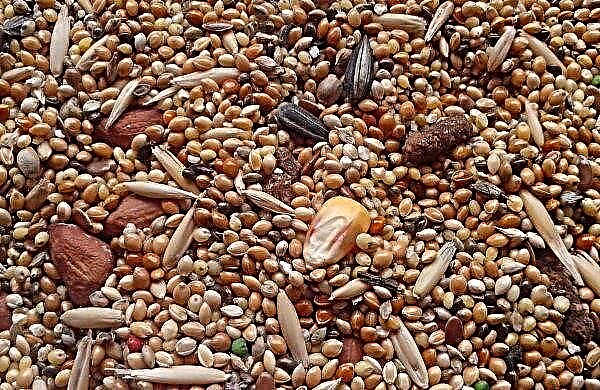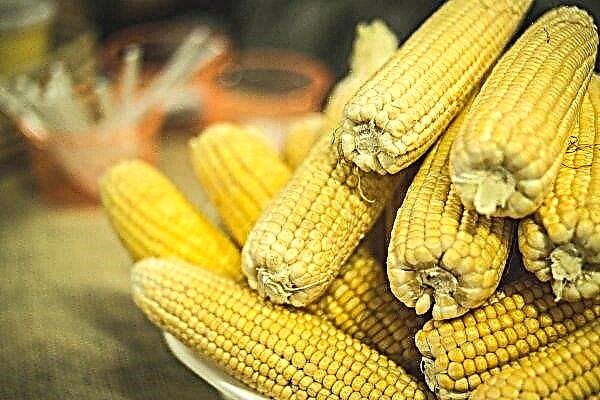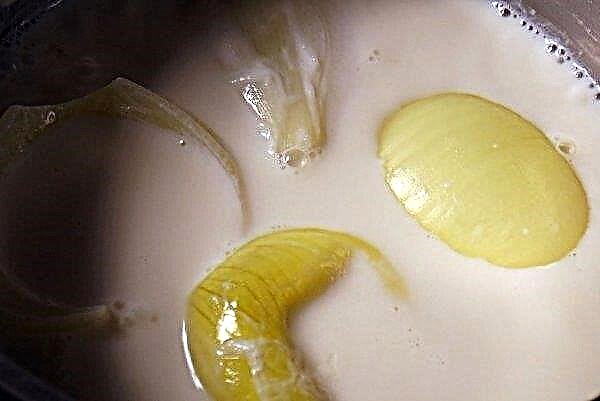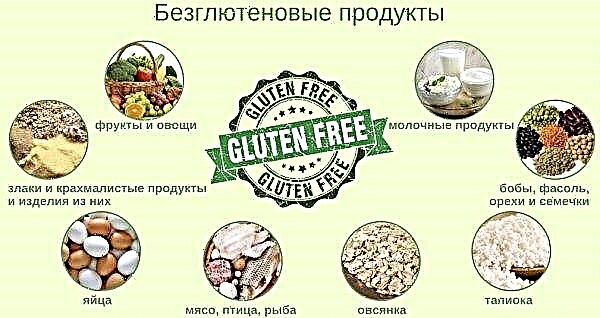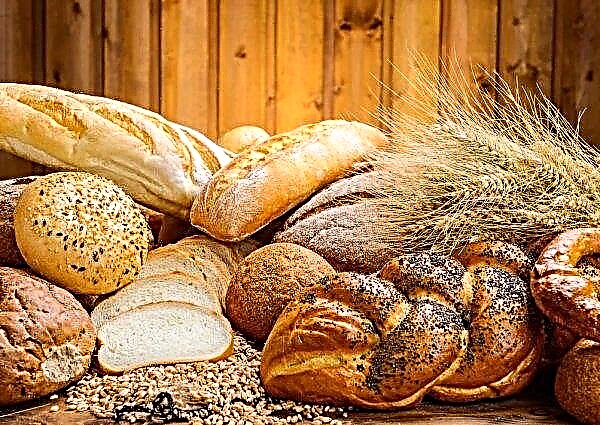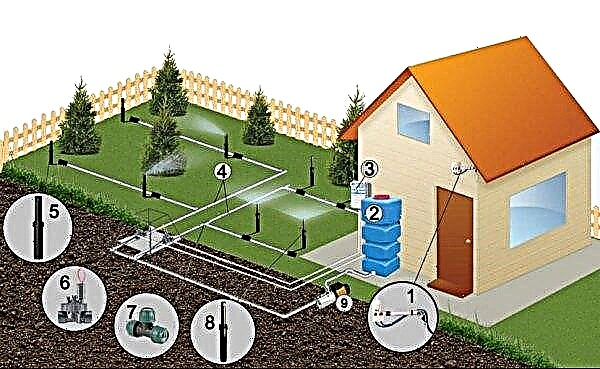Mirabella F1 cucumbers annually collect positive reviews from gardeners from different regions. The hybrid really has many advantages. However, in the cultivation of varieties there are a number of features that should be considered before planting. On cultivating the Mirabella F1 variety, read further in the article.
Description and characteristics of the variety Mirabella F1
Mirabella Cucumbers is a hybrid variety developed by Dutch breeders. Before sowing the crop, pay attention to the description of the bush, fruits and yield characteristics.
Did you know? The name of the plant "cucumber" comes from the word Cucumber from Byzantine Greek and translated as "unripened."
The appearance of the bush
Bushes are classified as medium-sized. The stem grows to 5 m in length. The leaves are dark green, medium in size. Flowering occurs according to the female type. The ovaries are formed in a bunch, in one sinus up to 8 fruits are tied. The Mirabella F1 variety belongs to gherkin. Cucumbers are cylindrical in shape, grow up to 15 cm in length. The diameter of one fruit is on average 3-4 cm. The weight of one vegetable varies between 90–100 g. The peel of the emerald color with small bright stripes. Cucumbers have a large number of tubercles and black spikes.
Cucumbers are cylindrical in shape, grow up to 15 cm in length. The diameter of one fruit is on average 3-4 cm. The weight of one vegetable varies between 90–100 g. The peel of the emerald color with small bright stripes. Cucumbers have a large number of tubercles and black spikes.
The taste of cucumbers
Tasters note the high palatability of the fruit. The flesh is crispy, not watery. In most cases, bitterness is absent.
Fruitfulness
Mirabella hybrid is characterized by high productivity. From 1 m² of plantations, gardeners remove 20–25 kg of fruit.
Ripening and flowering periods
With timely planting, budding begins in June. The fruit ripening early, technical ripeness occurs 40–45 days after the appearance of the first seedlings.
Pros and cons of the variety
Hybrid has its pros and cons.
- Among the undoubted advantages of the Mirabella variety:
- early ripening;
- the ability to grow vegetables in a greenhouse and garden;
- lack of need for pollinators;
- 99% germination;
- undemanding care;
- keeping quality;
- transportability;
- resistance to most diseases;
- high productivity.
- However, the culture has several disadvantages:
- in the north only greenhouse cultivation is possible;
- low resistance to cold;
- lack of immunity to a number of pests;
- exactingness to the formation of a bush.
The main difference from other varieties is that Mirabella cucumbers are gherkin - the fruits grow small. Along with this, high productivity is noted. The hybrid belongs to parthenocarpic, which allows plants to pollinate independently and set fruit.
Features of sowing and growing
Mirabella F1 cucumbers can be grown in a greenhouse or in open ground. Regardless of the method of planting, seedlings are pre-grown. Seeds on seedlings are sown in early April.
Important! In the northern latitudes, the greenhouse cultivation method is preferred. In the middle lane and in the south, landing in the garden is allowed.
The process of growing seedlings is as follows:
- Soak the seeds in water.
- Prepare peat cups.
- When sprouts emerge from the seeds, transfer the material to peat cups.
- Keep crops in a room with a temperature of +22 ... + 28 ° С.
- Periodically moisten the soil from the spray gun, the frequency depends on the drying rate of the substrate.
 25-30 days after the appearance of the first sprouts, the seedlings will have 3-4 true leaves. At this point, it can be transplanted into a greenhouse or garden. The approximate dates of transplantation are mid-May.
25-30 days after the appearance of the first sprouts, the seedlings will have 3-4 true leaves. At this point, it can be transplanted into a greenhouse or garden. The approximate dates of transplantation are mid-May.
In the open ground
When planting in open ground, select areas illuminated by the sun. The terrain must be protected from the wind. Also make sure that the soil has warmed up to + 15 ° С. The timing of transplanting seedlings can be rescheduled if cooling is expected.
Scheme of transplanting seedlings to a permanent place:
- Dig the soil half the spade bayonet.
- Dig holes according to the pattern of 0.4 m between rows and 0.2 m between plants.
- Moisten the seedlings in pots.
- Carefully remove the seedlings from the pots along with an earthen lump.
- Without shaking off the soil from the root system, move the seedlings to a permanent place.
- Cover the empty space in the wells with soil.
- Water the plantings.
 The scheme of planting cucumbers.
The scheme of planting cucumbers.Landing in the greenhouse
Before planting seedlings in a greenhouse, make sure that the daily temperature is kept at +25 ... + 28 ° С, and the soil temperature is +14 ... + 16 ° С. Humidity should be 60–70%. It is also advisable to install a ventilation system, otherwise the greenhouse will need to be ventilated daily.
If all conditions are met, transplant seedlings using the following technology:
- Dig a site to a depth of 20 cm.
- Pour the soil with a 1% solution of potassium permanganate for disinfection.
- Dig the landing pits according to the pattern of 0.4 m between rows and 0.2 m between bushes.
- Water the plants in pots.
- Remove the seedlings from the pots.
- Without removing soil from the rhizome, move the plants to the wells.
- Dig holes so that there is no free space left in them.
- Water each bush with water until the soil ceases to absorb water.
Care Features
To obtain a quality crop, it is important to properly care for the plantings. Pay attention to watering, top dressing, tying, bush formation and soil care activities.
Frequency of irrigation and fertilizer
Watering is carried out as the soil dries. Moisture should not stagnate in the soil, but the substrate should not be allowed to dry. In hot planting times, you can water it daily. It is necessary to moisten the soil with water at a temperature of +24 ... + 25 ° С. The best time for irrigation is morning or evening.
Top dressing is carried out four times in the growing season:
- 2 weeks after sowing;
- during budding;
- at the beginning of fruiting;
- after collecting the first batch of fruits.
The variety responds well to organics.
Important! When fertilizing bushes, do not exceed the indicated doses of top dressing. Excessive feeding often leads to impaired plant development.
For fertilizer, agronomists are advised to use the following options:
- a solution of cow manure (1 kg per 6 liters of water);
- chicken infusion (600 g per bucket of water);
- slurry (1 kg per 8 liters of water).

Garter and bush formation
The bush is formed into one stem. The crop scheme is as follows:
- lateral shoots are grown from soil level to a height of 0.5 m;
- at the level of 0.5-0.8 m (5-6 sheets), shoots from the sinuses shorten to 20 cm, pinch the tops;
- at the level of 0.8–1 m, the shoots are shortened to 30–40 cm, pinch the tops;
- at a level above 1 m, the shoots are shortened to 40-50 cm.
Scourges must be tied to the trellis as they grow.
Soil care
Soil care consists of several simple operations:
- Loosening. The soil is fluffed after each moistening. If the soil is not loosened, it will be taken with a crust, which will impede the saturation of the root system with oxygen.
- Weeding. Weeds dig up as they grow. It is most convenient to carry out weeding immediately after loosening.
- Mulching. In order for the substrate to retain moisture better, the soil around the stems is covered with organic mulch - sawdust, hay or straw.
Did you know? Employees of a breeding station in the United Arab Emirates brought cube-shaped cucumbers. Such vegetables are convenient to store and transport. Taste qualities at the same time remained unchanged.
Prevention and control of diseases and pests
The variety is resistant to most diseases; however, one should be wary of pest attacks.
According to gardeners, Mirabella cucumbers most often affect:
- thin tick;
- thrips;
- aphid.
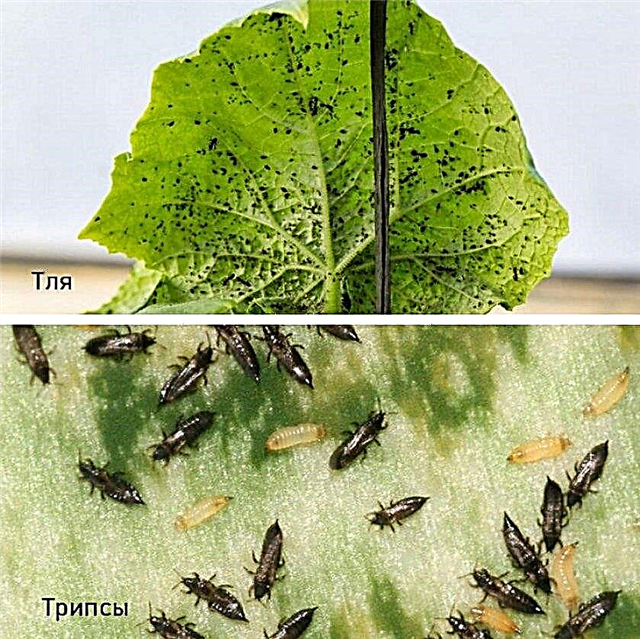 To combat these pests use the drug "Actellik" from the company "Syngenta". When grown in open ground, the agent is used twice with a break of 20 days. In greenhouses, cucumbers are processed three times, the waiting period is 3 days.
To combat these pests use the drug "Actellik" from the company "Syngenta". When grown in open ground, the agent is used twice with a break of 20 days. In greenhouses, cucumbers are processed three times, the waiting period is 3 days.Harvesting and storage
When the fruits begin to ripen, they are harvested every 3-4 days. With mass fruiting, the crop is harvested daily, without leaving for a long time on the bush. The use of cucumbers is universal. The fruits are suitable for pickling, pickling and fermentation. If fresh consumption is planned, the crop is stored in the vegetable section of the refrigerator for no more than 7 days.
High productivity, excellent taste and resistance to disease justify the high rating of the Mirabella F1 hybrid. With proper cultivation, timely watering, top dressing, bush formation and pest prevention, the gardener is guaranteed to get an excellent result.

